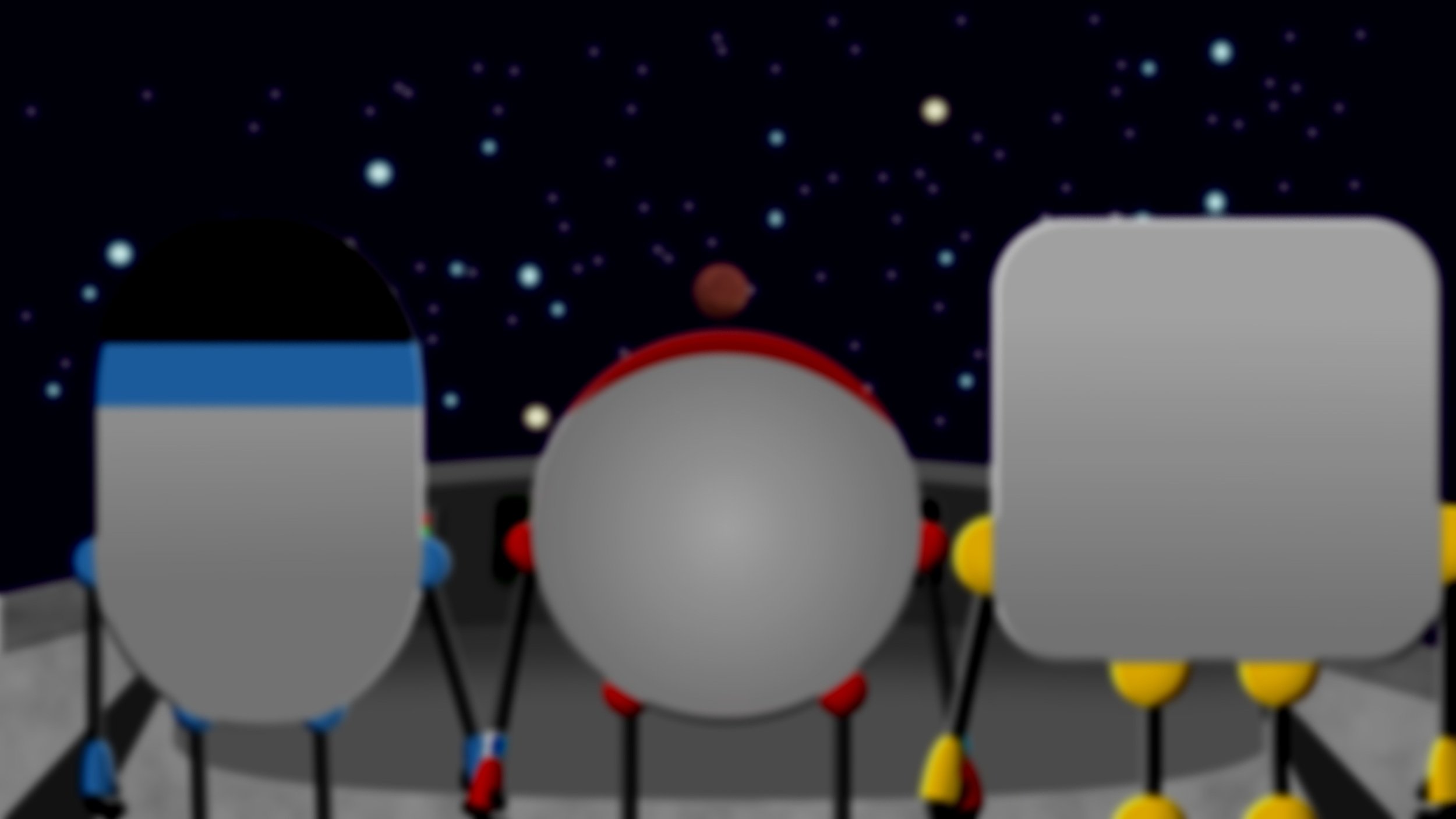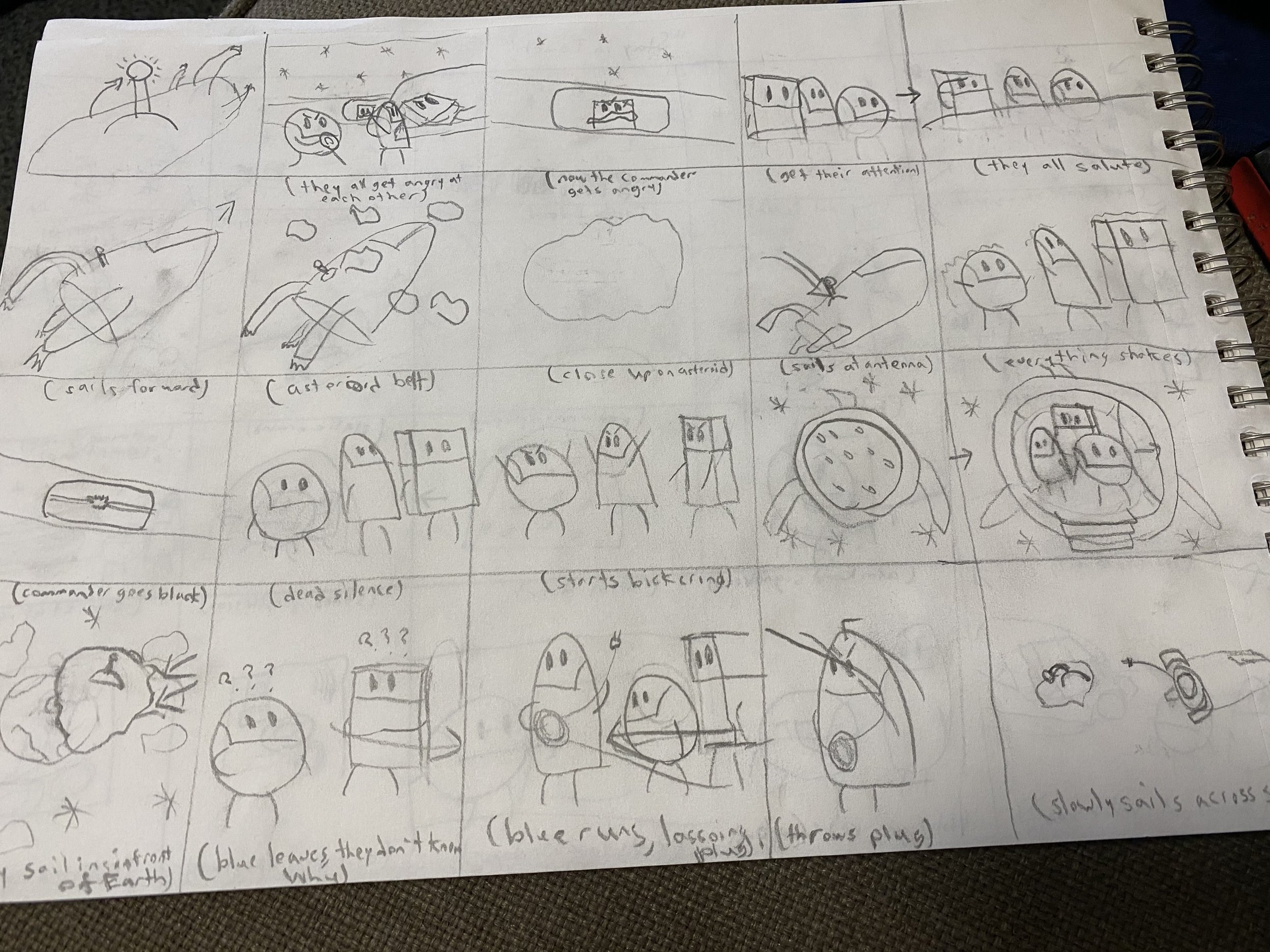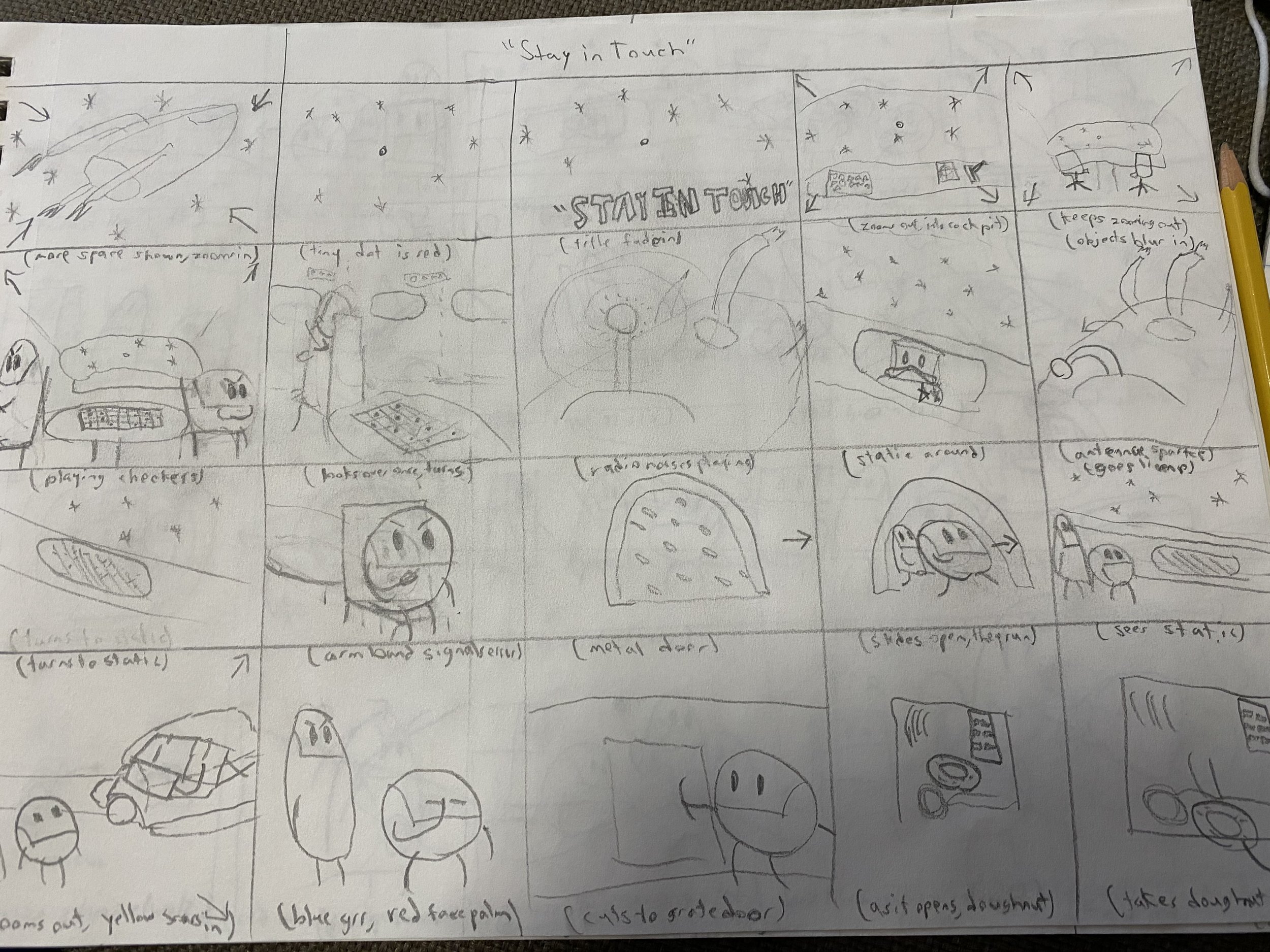“Stay in Touch”
A story about three robots trying to get along in their deep space pursuit to Mars.
(click to view)

To cap off my time at UConn properly, I wanted to make a fully animated short that tested the limits of my artistic knowledge.
As is the case with every project, it was all about how best to tell a story, and what workflow will accomplish it.Though I graduated with a concentration in 3D, I loved After Effects so much that I wanted to showcase my full experience. I used DuiK for the characters and Cinema 4D for the asteroids in the background. It took four months in total from January to April, where I was working roughly 8 hours a day. It was a ton of work, but extremely worth it.

Planning Process
Storyboarding is hard because I can’t draw. That’s why I knew I had to storyboard.
One truth pill I think every great storyteller has to swallow is that storytelling is embarrassing. It’s taking a part of yourself and putting it on a metaphorical canvas for everybody to see. That’s not something everybody can do—knowing that nothing you do will leave you fully comfortable to release. However, that’s why I love storytelling in the first place—the challenges you’re tested to overcome.
Naturally, you’d need a bit of structure. I never wanted to find myself in a place where I disagreed with what came next in the middle of production. I drew out the entire storyboard with my minimal illustration knowledge and worked on the background shots that I absolutely, positively needed. Discovering the pacing was pure instinct. I took the individual frames, threw them into Adobe Premiere and felt out the timing of each shot. I wanted it to look floaty and slow, but not sluggish. In the end, I came out with about 5 minutes of footage that I was truly proud of.
And I never would’ve gotten there without that first move. That long, excruciating decision turned into all this.

Animation
The moment I started “Stay in Touch”, I knew what it was going to look like.
From then on out, I was exploding with inspiration. I developed a simple, cartoony style that easily communicated characters from the background. After much deliberation, we landed on a slightly desaturated palette to make the characters pop off the screen. It was my idea to go fully 3D with the asteroids, because I wanted to portray how large and scary the vastness of space was to these cute little robot voyagers.
95% of the animation was done through an After Effects plugin, some effects that were keyframed, and a LOT of pre-comps. The rest went through Cinema 4D. It was my idea to use it for the asteroids to show how larger-than-life the vastness of space is in comparison to the small, cute robot voyagers. I even used it for barely noticeable things, like making a CGI finger so it would bend in an ultra-specific way which After Effects didn’t allow. The problem solving in this project was some of the most intriguing work I’ve ever done, and it completely changed my approach to the industry. We’re not just making art—we’re solving problems.
(and looking back at it, I definitely could’ve made the spaceship 3D, too.)
Post-Production
All 2D…sort of.
The arrangement in Premiere would become the bedrock of this project. In order to save the most time on rendering while leaving room for fixes, the blocks were arranged with the characters at the top, then the ship backgrounds, then deep space. Sound effects were not added until the very end (and I am SHOCKED at how long it really took, shout out to SFX artists), including the song I had commissioned from Cadence Hira (djivvi on Soundcloud). It was nothing out of the ordinary, but it still taught me a lot about proper organization.
Post-production? Is reeeeeeally hard. When every shot gets redone a million times, glaring mistakes are inevitable. For example, the titles of these After Effects files? Never do this. Early on, I thought it would be a good idea to name each file after what’s happening in the shot, but this led to a very disorganized and confusing assembly process. If I had named them all after their order of appearance, it turns out, this would have been much easier—and that’s exactly what I ended up doing for the .mp4 exports.
Speaking of, since they were timed to their respected frames, all I had to do was hold Alt and drag them on top.
“Stay in Touch” wasn’t just my biggest animation—it was my largest sound design project, too.
I spent days scouring the internet for free stock sound effects to build the atmosphere. At times, I had to edit and string them together in Audition to make them work. Some of these waveforms took hours, like when the ship’s alarms go off. It was a lot longer of a process than I was expecting, but hey, now I have a sound effect folder!
The voices of each robot were recorded with otamatones. They’re this musical note shaped, kind of dorky looking electrical instrument that “talk” in the tone that’s pressed on its neck (think like a saxophone with a mouth). I even reached out to a YouTube channel on how best to record them. After that, it was a matter of channeling them to a surround sound experience and sending it off.
Reception: Pretty Good!
Everybody I showed the video to enjoyed it It felt like a first step into the professionalism of directing a real live broadcasted television show. That kind of euphoria is why I throw myself in the brig for story—the real, honest impact your message has on others, which you can see right in the moment. Most of the time, it’s neutral. Other times, it’s nice, but you can clearly see right through it. Here, the reactions I remember most are the ones that went, “wow, we need to take this guy seriously.”

Conclusion
“Stay in Touch” was a voyage in it of itself.
This was an uncharted mission, and I wouldn’t have it any other way. I learned a ton more about After Effects as an engine, got to collaborate with some amazing artists (i.e. the song in the end), and got experience with being a leader. It taught me the pitfalls and extents of a large-scale project under a deadline that turned out to be surprisingly tight. I learned that workflow is the bedrock of everything you create, and the goal of the professional is not solely to increase his skill, but also to find the best way to streamline the process. I learned more about color palettes, improved my keyframing, learned how plugins work and gave myself an amazing portfolio addition.
When you’re doing a project of this caliber, you’re going to make mistakes. Sometimes, you can avoid a massive load of spaghetti code by asking a couple questions. Other times, the mistakes will come solely from your approach. What all mistakes have in common is they teach you how to do something better. Combine that with collaboration, and you’re bound to grow with your story.
Even now, that ending shot still sticks with me. It’s something about that yearning feel, the slow piano, and the subtle, bittersweet wrap-up as they accept that all they’ve got is each other. I think it reflected what I was feeling at the time—even now, when I start a big, new project, it’s like staring at some anomaly twinkling untouched, millions upon millions of years away. I want to get there, but there’s all this space between us. It’s daunting. And it may not even be what I wanted. To me, though, that doesn’t matter. I did it because I love stories. Because I love collaborating, and I love After Effects. Most of all, though, I care about putting my words out there and seeing where it hits. And even if nobody ends up remembering it, well, I do.
“Stay in Touch” continues to be my favorite project I’ve ever done, and has inspired a new voyage to be a full time director.
The distance between me and there, of course, remains to be seen.
























